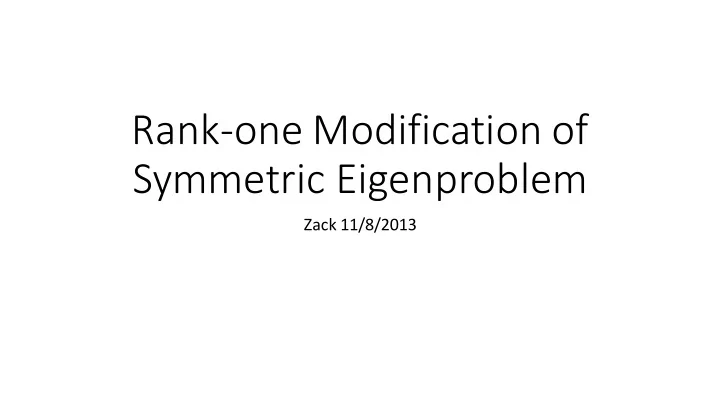

Rank-one Modification of Symmetric Eigenproblem Zack 11/8/2013
Eigenproblem • 𝐵 = 𝑅𝐸𝑅 𝑈 • Q is an orthonormal matrix, 𝑅𝑅 𝑈 = 𝑅 𝑈 𝑅 = 𝐽 • D is diagonal matrix, 𝑒 1 ≤ 𝑒 2 ≤ ⋯ ≤ 𝑒 𝑜
Initial modification of eigenproblem 𝐵 = 𝐵 + 𝜏𝑣𝑣 𝑈 • • 𝐵 = 𝑅𝐸𝑅 𝑈 is known. • Compute eigenvalue decomposition of 𝐵 : 𝐵 = 𝑅 𝐸 𝑅
𝐵 = 𝐵 + 𝜏𝑣𝑣 𝑈 = 𝑅 𝐸 + 𝜏𝑨𝑨 𝑈 𝑅 𝑈 • • Define C = 𝐸 + 𝜏𝑨𝑨 𝑈 , problem comes to eigenvalue decomposition of matrix C
• The eigenvalues of the matrix C satisfy the equation: det 𝐸 + 𝜏𝑨𝑨 𝑈 − λ𝐽 = 0 • det 𝐸 + 𝜏𝑨𝑨 𝑈 − λ𝐽 = det 𝐸 − λ𝐽 det 𝐽 + 𝜏 𝐸 − λ𝐽 −1 𝑨𝑨 𝑈 𝑜 𝑜 2 𝜂 𝑗 = ( 𝑒 𝑗 − 𝜇 )(1 + σ 𝑒 𝑗 − 𝜇 ) 𝑗=1 𝑗=1
𝑜 2 𝜂 𝑗 1 + σ 𝑒 𝑗 − 𝜇 = 0 𝑗=1
𝑜 2 𝜂 𝑗 1 + σ 𝑒 𝑗 − 𝜇 = 0 𝑗=1 • Define 𝜇 = 𝑒 𝑗 + 𝜏𝑢 , 𝜀 𝑘 = (𝑒 𝑘 − 𝑒 𝑗 )/𝜏 𝑜 2 𝜂 𝑘 𝑥 𝑗 𝑢 = 1 + 𝜀 𝑘 − 𝑢 = 0 𝑢 ∈ (0, 𝜀 𝑗+1 ) 𝑘=1
Newton’s method would be an obvious choice for finding the solution. However, Newton’s method is based on a local linear approximation to the function. Since our functions are rational functions, it seems more natural to develop a method based on a local approximation via simple rational function f(t).
Step1: choose an approximate function , for example: 𝑢→0 𝑔 𝑢 = −∞ lim 𝑐 𝑑 𝑔 𝑢 = 𝑏 + 𝑢 + lim 𝑢→𝜀 𝑔 𝑢 = +∞ 𝜀−𝑢 Step2: iteration 1. Choose 𝑢 0 ∈ (0, δ) 2. solve 𝑏 0 ,𝑐 0 , 𝑑 0 , with 𝑔 𝑢 0 = 𝑥 𝑗 𝑢 0 , 𝑔′ 𝑢 0 = 𝑥 𝑗 ′ 𝑢 0 , 𝑔′′ 𝑢 0 = 𝑥 𝑗 ′′ 𝑢 0 … 3. solve 𝑔 𝑢 1 = 0
𝑐 𝑑 • 𝑔 𝑢 = 𝑏 + 𝜀−𝑢 Gragg’s method 𝑢 + Converges from any point in 0, 𝜀 with a cubic order of convergence. 2 𝜂 𝑗 𝑐 • 𝑔 𝑢 = 𝑏 − 𝜀−𝑢 fixed weight 1 method (FW1) 𝑢 + 2 𝑐 𝜂 𝑗+1 𝜀−𝑢 fixed weight 2 method (FW2) 𝑔 𝑢 = 𝑏 + 𝑢 + Converges from any point in 0, 𝜀 with quadratic order of convergence
• Divide 𝑥 𝑗 𝑢 into 2 part: 𝑗 𝑜 2 2 𝜂 𝑘 𝜂 𝑘 𝑥 𝑗 𝑢 = 1 + 𝜀 𝑘 − 𝑢 + 𝜀 𝑘 − 𝑢 𝑘=1 𝑘=𝑗+1 = 1 + 𝜔 𝑢 + 𝜚(𝑢)
𝑗 2 𝜂 𝑘 𝜔 𝑢 = 𝜀 𝑘 − 𝑢 𝑘=1 𝑜 2 𝜂 𝑘 𝜚 𝑢 = 𝜀 𝑘 − 𝑢 𝑘=𝑗+1 𝜀 1 < ⋯ < 𝜀 𝑗 = 0 < 𝜀 𝑗+1 < ⋯ < 𝜀 𝑜
• choose an approximate function for 𝜔 𝑢 ,𝜚 𝑢 𝜔 𝑢 𝑏 + 𝑐𝑢 −1 𝜚 𝑢 𝑑 + 𝑒(𝜀 − 𝑢) −1 This method is named “the middle way”. For this method, convergence cannot be guaranteed unless the starting point lies close enough to the root. In case of convergence, the order is quadratic.
“approaching from the left” (BNS1) 𝜔 𝑢 𝑏(𝑐 − 𝑢) −1 𝜚 𝑢 𝑑 + 𝑒(𝜀 − 𝑢) −1 Converge from any point in (0, 𝑢 ∗ ] and the order of convergence is quadratic. “approaching from the right” (BNS2) 𝜔 𝑢 𝑏 + 𝑐𝑢 −1 𝜚 𝑢 𝑑(𝑒 − 𝑢) −1 Converge from any point in [𝑢 ∗ ,𝜀) and the order of convergence is quadratic.
Starting points 𝑜 2 𝜂 𝑘 1 + 𝑘 − 𝑢 = 0 𝜀 𝑘=1 𝑜 2 2 2 𝜂 𝑘 1 − 𝜂 𝑗 𝜂 𝑗+1 𝑢 + 𝜀 𝑗+1 − 𝑢 + 𝑘 − 𝑢 = 0 𝜀 𝑘=1 𝑘≠𝑗,𝑗+1 𝑜 2 2 2 𝜂 𝑘 1 − 𝜂 𝑗 𝜂 𝑗+1 + + ≈ 0 𝑢 0 𝜀 𝑗+1 − 𝑢 0 𝜀 𝑘 − 𝜀 𝑗+1 𝑘=1 𝑘≠𝑗,𝑗+1
Calculating the eigenvector • Assume 𝑟 𝑗 is 𝑗 th eigenvector of matrix A 𝑟 𝑗 − 𝐵 𝑒 𝑗 𝑟 𝑗 = 0 • if 𝑨 = 𝑅 𝑈 𝑐 and 𝑦 𝑗 = 𝑅 𝑈 𝑟 𝑗 𝑒 𝑗 𝐽 + 𝜏𝑨𝑨 𝑈 𝑦 𝑗 = 0 𝐸 −
Calculating the eigenvector • Theorem. If A is invertable and 𝜍 ≠ 0 , the following statements are equivalent: 𝐵 + 𝜍𝑣𝑤 𝑈 𝑦 = 𝑐 And 1 𝑦 = 𝐵 −1 𝑐 − 𝜄𝐵 −1 𝑣 , 𝜈𝜄 = 𝑤 𝑈 𝐵 −1 𝑐 , where 𝜈 = ( 𝜍 + 𝑤 𝑈 𝐵 −1 𝑣) 𝑒 𝑗 𝐽) −1 𝑨 • Therefore, 𝑦 𝑗 = −𝜄(𝐸 −
Q&A
Recommend
More recommend